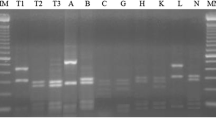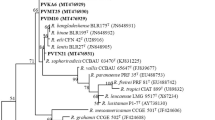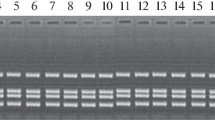Abstract
One hundred isolates were trapped by soybean (Glycine max) plants inoculated with a soil from the Cerrados, the main producing area in Brazil. The soil was originally void of rhizobia able to nodulate soybean, and 15 years before received inoculant containing Bradyrhizobium elkanii strains SEMIA 587 and SEMIA 5019; the area has been annually cropped with soybean since then, but with no further inoculation for the past 7 years. Enormous diversity was observed among the isolates, with thirteen serologically distinct groups, twelve protein and seven lipopolysaccharide profiles; no more than five isolates shared similar characteristics. An unexpected feature was that 48% of the isolates showed multiple reactions with the antisera to the serogroups established in the soils. Also 40% of the isolates reacted with the antiserum to B. japonicum strain SEMIA 566, that has never been introduced into the soil, probably due to dispersion from other cropping areas, associated with its high saprophytic competence; 13% of the isolates did not react with any of the antisera. Nodulation and N2 fixation capacity also varied considerably among the isolates. Although one third of the isolates were fast growers with an acid reaction in vitro, and many formed pseudo-nodules on common bean (Phaseolus vulgaris), they shared several properties with the Bradyrhizobium inoculant strains. A high level of genetic diversity was confirmed when the DNAs were amplified with BOX and RPO1 primers, and several isolates were positioned in far different clusters in the analysis of interspersed repetitive or nif-directed sequences. Moreover, serological properties showed higher correlation with BOX than with RPO1 products. The high diversity could be attributed both to lateral transfer of genetic material between inoculant and indigenous strains and to genomic rearrangements during the adaptation to the Cerrados, and may play an important role as a biological buffer, avoiding the dominance of a particular strain.
Similar content being viewed by others
References
Boddey, L.H. & Hungria, M. 1997 Determination of characteristics of Bradyrhizobium japonicum and B. elkanii species in Brazilian strains which nodulate soybean. Biology and Fertility of Soils 25, 407–415.
Chen, L.S., Figueredo, A., Pedrosa, F.O. & Hungria, M. 2000 Genetic characterization of soybean rhizobia in Paraguay. Applied and Environmental Microbiology 66, 5099–5103.
Chen, L.S., Figueredo, A., Villani, H., Michajluk, J. & Hungria, M. 2002 Diversity and symbiotic effectiveness of rhizobia isolated from field-grown soybean nodules in Paraguay. Biology and Fertility of Soils 35, 448–457.
Chen, W.X., Yan, G.H. & Li, J.L. 1988 Numerical taxonomic study of fast-growing soybean rhizobia and a proposal that Rhizobium fredii be assigned to Sinorhizobium gen. nov. International Journal of Systematic Bacteriology 38, 393–397.
Chueire, L.M.O., Bangel, E., Mostasso, F.L., Campo, R.J., Pedrosa, F.O. & Hungria, M. (in press) Classifição taxonômica das estirpes de rizóbio recomendadas para as culturas da soja e do feijoeiro baseada no seqüenciamento do gene 16s RNA. Revista Brasileira de Ciência do Solo.
agricola/Safra/Quadro9.xls.
Ferreira, M.C., Andrade, D.S., Chueire, L.M.O., Takemura, S.M. & Hungria, M. 2000 Tillage method and crop rotation effects on the population sizes and diversity of bradyrhizobia nodulating soybean. Soil Biology and Biochemistry 32, 627–637.
Ferreira, M.C. & Hungria, M. 2002 Recovery of soybean inoculant strains from uncropped soils in Brazil. Field Crops Research 79, 139–152.
Freire, J.R.J., Kolling, J., Vidor, C., Pereira, J.S., Kolling, I.G. & Mendes, N.G. 1983 Sobrevivência e competição por sítios de nodulação de estirpes de Rhizobium japonicum na cultura da soja. Revista Brasileira de Ciência do Solo 7, 47–53.
Graham, P.H. & Vance, C.P. 2003 Legumes: importance and constraints to greater utilization. Plant Physiology 131, 872–877.
Ham, G.E., Frederick, L.R. & Anderson, I.C. 1971 Serogroups of Rhizobium japonicum in soybean nodules samples in Iowa. Agronomy Journal 63, 69–72.
Hungria, M., Boddey, L.H., Santos, M.A. & Vargas M.A.T. 1998 Nitrogen fixation capacity and nodule occupancy by Bradyrhizobium japonicum and B. elkanii strains. Biology and Fertility of Soils 27, 393–399.
Hungria, M., Campo, R.J., Chueire, L.M., Grange, L. & Megias, M. 2001a Symbiotic effectiveness of fast-growing rhizobial strains isolated from soybean nodules in Brazil. Biology and Fertility of Soils 33, 387–394.
Hungria, M., Chueire, L.M.O., Coca, R.G. & Megías, M. 2001b Preliminary characterization of fast growing rhizobial strains isolated from soyabean nodules in Brazil. Soil Biology and Biochemistry 33, 1349–1361.
Hungria, M., Franchini, J.C., Campo, R.J. & Graham, P.H. in press The importance of nitrogen fixation to soybean cropping in South America. In Nitrogen Fixation Research: Origins and Perspectives, ed. Newton, W.E. vol. 7, Agriculture, Forestry, Ecology and Environment, co-ed Werner, D. Dordrecht: Kluwer Academic Publishers.
Hungria, M., Nishi, C.Y.M., Cohn, J. & Stacey, G. 1996 Comparison between parental and variant soybean Bradyrhizobium strains with regard to the production of lipo-chitin nodulation signals, early stages of root infection, nodule occupancy, and N2 fixation. Plant and Soil 186, 331–341.
Hungria, M. & Vargas, M.A.T. 2000 Environmental factors affecting N2 fixation in grain legumes in the tropics, with an emphasis on Brazil. Field Crops Research 65, 151–154.
Martínez-Romero, E. & Caballero-Mellado, J. 1996 Rhizobium phylogenies and bacterial diversity. Critical Reviews in Plant Sciences 15, 113–140.
Mendes, I.C., Vargas, M.A.T. & Hungria, M. 2000 Estabelecimento de estirpes de Bradyrhizobium japonicum/B. elkanii e seus efeitos na reinoculacção da soja em solos de Cerrado. Planaltina, DF, Brazil: Embrapa Cerrados. (Documentos 20).
Neves, M.C.P., Didonet, A.D., Duque, F.F. & Döbereiner, J. 1985 Rhizobium strain effects on nitrogen transport and distribution in soybeans. Journal of Experimental Botany 36, 1179–1192.
Nishi, C.Y.M., Boddey, L.H., Vargas, M.A.T. & Hungria, M. 1996 Morphological, physiological and genetic characterization of two new Bradyrhizobium strains recently recommended in Brazilian commercial inoculants for soybean. Symbiosis 20, 147–162.
Peres, J.R.R. 1979 Seleção de estirpes de Rhizobium japonicum e competitividade por sítios de infecção nodular em cultivares de soja (Glycine max (L.) Merrill). M.Sc. thesis, UFRGS-FA, Porto Alegre, RS, Brazil.
Peres, J.R.R. & Vidor, C. 1980 Seleção de estirpes de Rhizobium japonicum e competitividade por sítios de infecção nodular em cultivares de soja. Agronomia Sulriograndense 16, 205–219.
Peres, J.R.R., Mendes, I.C., Suhet, A.R. & Vargas, M.A.T. 1993 Eficiência e competitividade de estirpes de rizóbio para a soja em solos de Cerrados. Revista Brasileira de Ciência do Solo 17, 357–363.
Provorov, N.A. & Vorob'ev, N.I. 2000 Evolutionary genetics of nodule bacteria: molecular and populational aspects. Russian Journal of Genetics 36, 1323–1335.
Richardson, A.E., Viccars, L.A., Watson, J.M. & Gibson, A.H. 1995 Differentiation of Rhizobium strains using the polymerase chain reaction with random and directed primers. Soil Biology and Biochemistry 27, 515–524.
Santos, M.A., Vargas, M.A.T. & Hungria, M. 1999 Characterization of soybean bradyrhizobia strains adapted to the Brazilian Cerrados Region. FEMS Microbiology Ecology 30, 261–272.
Schloter, M., Lebuhn, M., Heulin, T. & Hartmann, A. 2000 Ecology and evolution of bacterial microdiversity. FEMS Microbiology Reviews 24, 647–660.
Scholla, M.H. & Elkan, G.H. 1984 Rhizobium fredii sp. nov., a fastgrowing species that effectively nodulates soybeans. International Journal of Systematic Bacteriology 34, 484–486.
Silva, C., Vinuesa, P., Eguiarte, L.E., Martínez-Romero, E. & Souza, V. 2003 Rhizobium etli and Rhizobium gallicum nodulate common bean (Phaseolus vulgaris) in a traditionally managed milpa plot in Mexico: population genetics and biogeographic implications. Applied and Environmental Microbiology 69, 884–893.
Sullivan, J.T., Patrick, H.N., Lowther, W.L., Scott, D.B. & Ronson, C.W. 1995 Nodulating strains of Rhizobium loti arise through chormosomal symbiotic gene transfer in the environment. Proceedings of the National Academy of Sciences of the USA 92, 8985–8989.
Thies, J.E, Singleton, P.W. & Bohlool, B.B. 1991 Influence of the size of indigenous rhizobial population on establishment and symbiotic performance of introduced rhizobia on field-grown legumes. Applied and Environmental Microbiology 57, 19–28.
Vargas, M.A.T. & Hungria, M. 1997 Fixação biológica do N2 na cultura da soja. In Biologia dos Solos de Cerrados, ed. Vargas, M.A.T. & Hungria, M. pp. 297–360. Planaltina, DF, Brazil: EMBRAPA-CPAC. ISBN 85-7075-006-4.
Vargas, M.A.T., Mendes, I.C., Suhet, A.R. & Peres, J.R.R. 1992 Duas novas estirpes de rizóbio para a inoculação da soja. Planaltina, DF, Brazil: EMBRAPA-CPAC. (Comunicado Técnico 62).
Vargas, M.A.T., Mendes, I.C., Suhet, A.R. & Peres, J.R.R. 1993 Serological distribution of Bradyrhizobium japonicum from Brazilian 'Cerrados' areas under soybean cultivation. Revista de Microbiologia 24, 239–243.
Vargas, M.A.T., Peres, J.R.R. & Suhet, A.R. 1982 Adubação nitrogenada, inoculação e épocas de calagem para a soja em um solo sob Cerrado. Pesquisa Agropecua´ria Brasileira 17, 1127–1132.
Vargas, M.A.T. & Suhet, A.R. 1980 Efeitos da inoculação e deficiência hídrica no desenvolvimento da soja em um solo de cerrado. Revista Brasileira de Ciência do Solo 4, 17–21.
Versalovic, J., Schneider, M., de Bruijn, F.J. & Lupski, J.R. 1994 Genomic fingerprinting of bacteria using repetitive sequence-based polymerase chain reaction. Methods in Molecular and Cellular Biology 5, 25–40.
Vincent, J.M., 1970 Manual for the Practical Study of Root Nodule Bacteria. Oxford, UK: Blackwell Scientific Publications. (IBP Handbook 15). ISBN 0-63206410-2.
Author information
Authors and Affiliations
Rights and permissions
About this article
Cite this article
Galli-Terasawa, L., Glienke-Blanco, C. & Hungria, M. Diversity of a soybean rhizobial population adapted to a Cerrados soil. World Journal of Microbiology and Biotechnology 19, 933–939 (2003). https://doi.org/10.1023/B:WIBI.0000007324.50022.c0
Issue Date:
DOI: https://doi.org/10.1023/B:WIBI.0000007324.50022.c0




